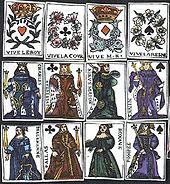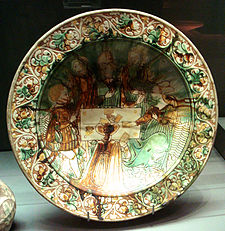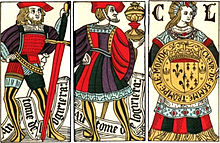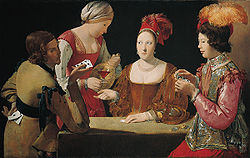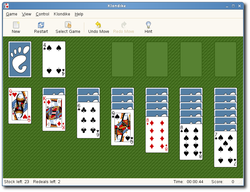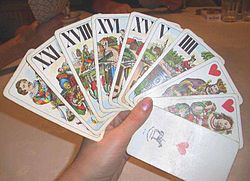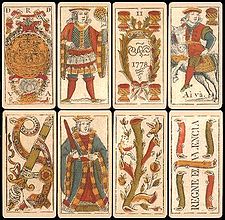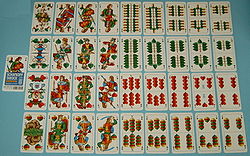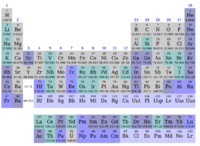
Playing card
Background Information
Arranging a Wikipedia selection for schools in the developing world without internet was an initiative by SOS Children. Before you decide about sponsoring a child, why not learn about different sponsorship charities first?
A playing card is a piece of specially prepared heavy paper, thin cardboard, plastic-coated paper, cotton-paper blend, or thin plastic, marked with distinguishing motifs and used as one of a set for playing card games. Playing cards are typically palm-sized for convenient handling.
A complete set of cards is called a pack (UK English) or deck (US English), and the subset of cards held at one time by a player during a game is commonly called a hand. A deck of cards may be used for playing a great variety of card games, with varying elements of skill and chance, some of which are played for money. Because playing cards are commonly available and somewhat standardized, they are also used for purposes other than playing, such as illusions, cardistry, and building card structures. Similar cards are used for cartomancy.
The front (or "face") of each card carries markings that distinguish it from the other cards in the deck and determine its use under the rules of the game being played. The back of each card is identical for all cards in any particular deck, and usually of a single colour or formalized design. Usually every card will be smooth; however, some decks have braille to allow blind people to read the card number and suit. The backs of playing cards are sometimes used for advertising. For most games, the cards are assembled into a deck, and their order is randomized by shuffling.
History
Early history
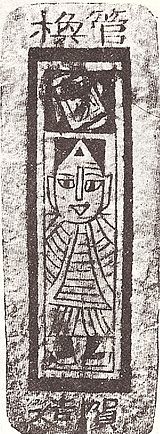
Playing cards were invented in ancient China. They were found in China as early as the 9th century during the Tang Dynasty (618–907). The first reference to card games in world history dates from the 9th century, when the Collection of Miscellanea at Duyang, written by Tang Dynasty writer Su E, described Princess Tongchang, daughter of Emperor Yizong of Tang, playing the "leaf game" in 868 with members of the Wei clan, the family of the princess' husband. The Song Dynasty (960–1279) scholar Ouyang Xiu (1007–1072) asserted that playing cards and card games existed at least since the mid-Tang Dynasty and associated their invention with the simultaneous development of using sheets or pages instead of paper rolls as a writing medium. The first known book on cards called Yezi Gexi was allegedly written by a Tang era woman, and was commented on by Chinese writers of subsequent dynasties.
By the 11th century, playing cards could be found throughout the Asian continent. During the Ming Dynasty (1368–1644), characters from popular novels such as the Water Margin were widely featured on the faces of playing cards.
Ancient Chinese "money cards" have four suits: coins (or cash), strings of coins (which may have been misinterpreted as sticks from crude drawings), myriads (of coins or of strings), and tens of myriads (a myriad is 10,000). These were represented by ideograms, with numerals of 2–9 in the first three suits and numerals 1–9 in the "tens of myriads". Wilkinson suggests that the first cards may have been actual paper currency which were both the tools of gaming and the stakes being played for, as in trading card games. The designs on modern Mahjong tiles likely evolved from those earliest playing cards. However, it may be that the first deck of cards ever printed was a Chinese domino deck, in whose cards all 21 combinations of a pair of dice are depicted. In Kuei-t'ien-lu, a Chinese text redacted in the 11th century, domino cards were printed during the Tang Dynasty, contemporary to the first printed books. The Chinese word pái (牌) is used to describe both paper cards and gaming tiles.
Introduction into Europe
Playing cards first entered Europe in the late 14th century, probably from Mamluk Egypt, with suits (sets of cards with matching designs) very similar to the tarot suits of Swords, Staves, Cups and Coins (also known as disks or pentacles), and which are still used in traditional Italian, Spanish, and Portuguese decks. The first documentary evidence is a ban on their use in 1367, Bern, Switzerland. Their presence is attested in Catalonia in 1371. Wide use of playing cards in Europe can, with some certainty, be traced from 1377 onwards.
The Mameluke deck contained 52 cards comprising four "suits:" polo sticks, coins, swords, and cups. Each suit contained ten "spot" cards (cards identified by the number of suit symbols or "pips" they show) and three "court" cards named malik (King), nā'ib malik (Viceroy or Deputy King), and thānī nā'ib (Second or Under-Deputy). The Mameluke court cards showed abstract designs not depicting persons (at least not in any surviving specimens), though they did bear the names of military officers.
A complete pack of Mameluke playing cards was discovered by Leo Mayer in the Topkapı Palace, Istanbul, in 1939. This particular complete pack was not made before 1400, but the complete deck was matched to a privately owned fragment dated to the 12th or 13th century. It is not a complete deck, but there are cards of three packs of the same style.

It is not known whether these cards influenced the design of the Indian cards used for the game of Ganjifa, or whether the Indian cards may have influenced these. Regardless, the Indian cards have many distinctive features: they are round, generally hand painted with intricate designs, and comprise more than four suits—often as many as thirty two, like a deck in the Deutsches Spielkarten-Museum, painted in the Mewar, a city in Rajasthan, between the 18th and 19th century. Decks used to play have from eight up to twenty suits.
Spread across Europe and early design changes
In the late 14th century, the use of playing cards spread rapidly throughout Europe. Documents mentioning cards date from 1371 in Spain, 1377 in Switzerland, and 1380 in many locations including Florence and Paris. A 1369 Paris ordinance (on gaming?) does not mention cards, but its 1377 update does. In the account books of Johanna, Duchess of Brabant and Wenceslaus I, Duke of Luxemburg, an entry dated May 14, 1379 reads: "Given to Monsieur and Madame four peters, two forms, value eight and a half moutons, wherewith to buy a pack of cards". In his book of accounts for 1392 or 1393, Charles or Charbot Poupart, treasurer of the household of Charles VI of France, records payment for the painting of three sets of cards.
The earliest cards were made by hand, like those designed for Charles VI; this was expensive. Printed woodcut decks appeared in the 15th century. The technique of printing woodcuts to decorate fabric was transferred to printing on paper around 1400 in Christian Europe, very shortly after the first recorded manufacture of paper there, while in Islamic Spain it was much older. The earliest dated European woodcut is 1418.
No examples of printed cards from before 1423 survive. But from about 1418 to 1450 professional card makers in Ulm, Nuremberg, and Augsburg created printed decks. Playing cards even competed with devotional images as the most common uses for woodcut in this period.
Most early woodcuts of all types were coloured after printing, either by hand or, from about 1450 onwards, stencils. These 15th-century playing cards were probably painted.
The Master of the Playing Cards worked in Germany from the 1430s with the newly invented printmaking technique of engraving. Several other important engravers also made cards, including Master ES and Martin Schongauer. Engraving was much more expensive than woodcut, and engraved cards must have been relatively unusual.
In the 15th century in Europe, the suits of playing cards varied: typically a deck had four suits, although five suits were common and other arrangements are also known. In Germany, hearts (Herz/Rot), bells (Schellen), leaves (Grün), and acorns (Eichel) became the standard suits and are still used in Eastern and Southeastern German decks today for Skat, Schafkopf, Doppelkopf, and other games. Italian and Spanish cards of the 15th century used swords, batons (or wands), cups, and coins (or rings). The Tarot, which included extra trump cards, was invented in Italy in the 15th century.
The four suits now used in most of the world — spades, hearts, diamonds, and clubs — originated in France in about 1480. The trèfle (club) was probably derived from the acorn and the pique (spade) from the leaf of the German suits. The names "pique" and "spade", however, may have derived from the sword of the Italian suits. In England, the French suits were eventually used, although the earliest decks had the Italian suits.
Also in the 15th century, Europeans changed the court cards to represent European royalty and attendants, originally "king", "chevalier" (knight), and "knave". The original meaning of knave was male child (cf German Knabe), so in this context the character could represent the "prince", son to the King and Queen; the meaning servant developed later. In a German pack from the 1440s, Queens replace Kings in two of the suits as the highest card. Decks of 56 cards containing in each suit a King, Queen, Knight, and Valet (from the French tarot court) were common.
Court cards designed in the 16th century in the manufacturing centre of Rouen became the standard design in England, while a Parisian design became standard in France. Both the Parisian and Rouennais court cards were named after historical and mythological heroes and heroines. The Parisian names have become more common in modern use, even with cards of Rouennais design.
| Modern Paris court card name | Traditional Paris court card name |
|---|---|
| King of Spades | David |
| King of Hearts | Charles (possibly Charlemagne, or Charles VII, in which case Rachel (see below) would be the pseudonym of his mistress, Agnès Sorel) |
| King of Diamonds | Julius Caesar |
| King of Clubs | Alexander the Great |
| Queen of Spades | Pallas |
| Queen of Hearts | Judith |
| Queen of Diamonds | Rachel (either biblical, historical (see Charles above), or mythical as a corruption of the Celtic Ragnel, relating to Lancelot below) |
| Queen of Clubs | Argine (possibly an anagram of regina, which is Latin for queen, or perhaps Argea, wife of Polybus and mother of Argus) |
| Knave of Spades | Ogier the Dane/Holger Danske (a knight of Charlemagne) |
| Knave of Hearts | La Hire (comrade-in-arms to Joan of Arc, and member of Charles VII's court) |
| Knave of Diamonds | Hector |
| Knave of Clubs | Judas Maccabeus, or Lancelot |
Later design changes
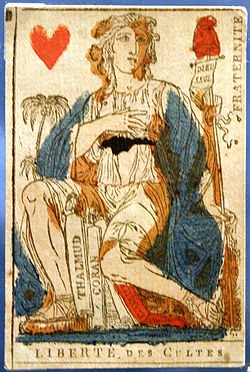
In early games the kings were always the highest card in their suit. However, as early as the late 14th century special significance began to be placed on the nominally lowest card, now called the Ace, so that it sometimes became the highest card and the Two, or Deuce, the lowest. This concept may have been hastened in the late 18th century by the French Revolution, where games began being played "ace high" as a symbol of lower classes rising in power above the royalty. The term "Ace" itself comes from a dicing term in Anglo-Norman language, which is itself derived from the Latin as (the smallest unit of coinage). Another dicing term, trey (3), sometimes shows up in playing card games.
Packs with corner and edge indices (i.e. the value of the card printed at the corner(s) of the card) enabled players to hold their cards close together in a fan with one hand (instead of the two hands previously used). The first such deck known with Latin suits was printed by Infirerra and dated 1693 (International Playing Cards Society Journal 30-1 page 34), but this feature was commonly used only from the end of 18th century. Indices in the Anglo-American deck were used from 1875, when the New York Consolidated Card Company patented the Squeezers, the first cards with indices that had a large diffusion. However the first Anglo-American deck with this innovation was the Saladee's Patent, printed by Samuel Hart in 1864.
Before this time, the lowest court card in an English deck was officially termed the Knave, but its abbreviation ("Kn") was too similar to the King ("K") and thus this term did not adapt well to indices. However, from the 17th century the Knave had often been termed the Jack, a term borrowed from the English Renaissance card game All Fours where the Knave of trumps has this name. All Fours was considered a game of the lower classes, so the use of the term Jack at one time was considered vulgar. The use of indices, however, encouraged a formal change from Knave to Jack in English language decks. In other languages, this conflict does not exist: the French tarot deck for instance labels its lowest court card the "Valet", which is the "squire" to the Knight card (not seen in 52-card decks) as the Queen is paired with the King. This name, abbreviated "V", is used for modern 52 card packs in the French language.
This was followed by the innovation of reversible court cards. This invention is attributed to a French card maker of Agen in 1745. But the French government, which controlled the design of playing cards, prohibited the printing of cards with this innovation. In central Europe (trappola cards), Italy (tarocchino bolognese) and in Spain the innovation was adopted during the second half of 18th century. In Great Britain the deck with reversible court cards was patented in 1799 by Edmund Ludlow and Ann Wilcox. The Anglo-American pack with this design was printed around 1802 by Thomas Wheeler. Reversible court cards meant that players had no need to turn upside-down court cards right side up. Before this, other players could often get a hint of what other players' hands contained by watching them reverse their cards. This innovation required abandoning some of the design elements of the earlier full-length courts.
During the French Revolution, the traditional design of Kings, Queens, and Jacks became Liberties, Equalities, and Fraternities. The radical French government of 1793 and 1794 toppled the old regime and a good revolutionary would not play with Kings or Queens, but with the ideals of the revolution at hand. This would ultimately be reversed in 1805 with the rise of Napoleon.
The United States introduced the joker into the deck. The stylings of the joker and its function are almost identical to the Fool from the original French Tarot deck, which had been removed in the transformation to the standard 52-card French deck. It was devised for the game of Euchre, which spread from Europe to America beginning shortly after the American Revolutionary War and was very popular by the mid-19th century. In Euchre, the highest trump card is the Jack of the trump suit, called the right bower (or bauer); the second-highest trump, the left bower, is the Jack of the suit of the same colour as trumps. The joker was invented c. 1870 as a third trump, the best bower, which ranked higher than the other two bowers. The name of the card is believed to derive from juker, a variant name for Euchre.
In the 19th century, a type of card known as a transformation playing card became popular in Europe and America. In these cards, an artist incorporated the pips of the non-face cards into an artistic design.
Symbolism
Popular legend holds that the composition of a deck of cards has religious, mystical, or astrological significance.
Thus each suit of 13 cards represents the 13 months of the lunar year. Since the sidereal lunar month may be approximated to 28 days, each deck is equal to 364 days of the year.
Similarly, the whole deck of 52 cards represents the 52 weeks of the year. Therefore, the whole deck is also equal to 364 days of the year (the positivist calendar) with the four suits corresponding to the four seasons.
The ace is symbolically “ alpha and omega” or “the beginning and end.”
Current
French design
The primary deck of 52 playing cards in use today includes 13 ranks of each of the four French suits, clubs (♣), diamonds (♦), hearts (♥) and spades (♠), with reversible Rouennais "court" or face cards. Each suit includes an ace, depicting a single symbol of its suit (quite large often only on the ace of spades) a king, queen, and jack, each depicted with a symbol of their suit; and ranks two through ten, with each card depicting that number of symbols (pips) of its suit. As well as these 52 cards, commercial decks often include between one and four jokers, most often two. These Jokers are not used in most basic game rules, but have a variety of uses with rule variations, and can simply serve as "spares" to replace a damaged or lost card.
Sizes
The most common sizes for playing cards are poker size (2.5×3.5 inches (64×89 mm), or B8 size according to ISO 216) and bridge size (2.25×3.5 inches (57×89 mm)), the latter being narrower, and thus more suitable for games in which a large number of cards must be held concealed in a player's hand, such as Bridge. Other sizes are also available, such as a smaller size (usually 1.75×2.625 inches (44×66.7 mm)) for solitaire, tall narrow designs for travel and larger ones for card magic. The weight of an average B8-sized playing card is 0.063 ounces (1.8 g), and a deck 3.3 ounces (94 g).
Styling
Modern playing cards carry index labels on opposite corners so that the card can be identified when held in a fan from left to right, regardless of which of the two narrow edges faces up. These stylings, together with the popular imagery on the court cards, are sometimes referred to as "English" or "Anglo-American" and are the most popular forms of the French deck. Various alternative stylings include indices at all four corners, court indices in different languages, different court imagery or perhaps novelty stylings.
The embellished design and manufacturer's logo commonly displayed on the Ace of Spades began under the reign of James I of England, who passed a law requiring an insignia on that card as proof of payment of a tax on local manufacture of cards. Until August 4, 1960, decks of playing cards printed and sold in the United Kingdom were liable to tax under the Stamp Act 1765, and the Ace of Spades carried an indication of the name of the printer and the fact that the tax had been paid. The packs were also sealed with a government duty wrapper.
Though specific design elements of the court cards are not relevant to game play and many differ between designs, a few elements of the English pattern are notable. The Jack of Spades, Jack of Hearts, and King of Diamonds are drawn in profile, while the rest of the court are shown in full face; these cards are commonly called "one-eyed". When deciding which cards are to be made wild in some games, the phrase "acey, deucey, one-eyed jack" (or "deuces, aces, one-eyed faces") is sometimes used, which means that aces, twos, and the one-eyed jacks are all wild. The King of Hearts is the only King with no mustache, and is also typically shown with a sword behind his head, making him appear to be stabbing himself. This leads to the nickname "suicide king". The axe held by the King of Diamonds is behind his head with the blade facing toward him. He is traditionally armed with an axe while the other three kings are armed with swords, and thus the King of Diamonds is sometimes referred to as "the man with the axe". This is the basis of the trump " one-eyed jacks and the man with the axe". The Jack of Diamonds is sometimes known as "laughing boy". The Ace of Spades, unique in its large, ornate spade, is sometimes said to be the death card, and in some games is used as a trump card. The Queen of Spades usually holds a scepter and is sometimes known as "the bedpost Queen", though more often she is called "Black Lady". In many decks, the Queen of Clubs holds a flower. She is thus known as the "flower Queen" (though in many playing cards from Germany and Sweden she is depicted with a fan), but this design element is among the most variable; the standard Bicycle Poker deck depicts all Queens with a flower styled according to their suit.
There are theories about whom the court cards represent. For example, the Queen of Hearts is believed by some to be a representation of Elizabeth of York—the Queen consort of King Henry VII of England, or it is sometimes believed to be a representation of Anne Boleyn, the second wife of Henry VIII. The United States Playing Card Company suggests that, in the past, the King of Hearts was Charlemagne, the King of Diamonds was Julius Caesar, the King of Clubs was Alexander the Great, and the King of Spades was the Biblical King David (see King (playing card)). However, the Kings, Queens, and Jacks of Anglo-American designs today do not represent anyone in particular. They stem from designs produced in Rouen before 1516, and, by 1540–67, these Rouen designs show well executed pictures in the court cards with the typical court costumes of the time. In these early cards, the Jack of Spades, Jack of Hearts, and King of Diamonds are shown from the rear, with their heads turned back over the shoulder so that they are seen in profile; however, the Rouen cards were so badly copied in England that the current designs are gross distortions of the originals.
Other oddities such as the lack of a moustache on the King of Hearts also have little significance. The King of Hearts did originally have a moustache, but it was lost by poor copying of the original design. Similarly, the objects carried by the court cards have no significance. They merely differentiate one court card from another and have also become distorted over time.
Some decks include additional design elements: casino blackjack decks may include markings intended for a machine to check the ranks of cards. Many casino decks and solitaire decks have four indices instead of the usual two. Some decks have larger indices, often for use in stud poker games, where being able to read cards from a distance is a benefit and hand sizes are small. Some decks use four colors for the suits in order to make it easier to tell them apart: The most common set of colors for poker is black spades, red hearts, blue diamonds and green clubs (♠♥♦♣). Another common colour set is borrowed from the German suits and uses green spades (leaves) and yellow diamonds (bells) with red hearts and black clubs (♣♠♥♦).
Many modern decks have bar code markings on the edge of the face to enable them to be sorted by machine (for playing duplicate bridge, especially simultaneous events where the same hands may be played at many different venues).
When giving the full written name of a specific card, the rank is given first followed by the suit, e.g., "Ace of Spades". Shorthand notation may list the rank first "A♠" (as is typical when discussing poker) or list the suit first (as is typical in listing several cards in bridge) "♠AKQ".
Tens may be either abbreviated to T or written as 10.
| Suit | Ace | 2 | 3 | 4 | 5 | 6 | 7 | 8 | 9 | 10 | Jack | Queen | King |
|---|---|---|---|---|---|---|---|---|---|---|---|---|---|
| Spades | |||||||||||||
| Hearts | |||||||||||||
| Diamonds | |||||||||||||
| Clubs |
Piquet
The piquet deck is a subset of the French-suited 52-card deck, with all values from 2 through 6 in each suit removed. The resulting 32-card deck is notable for its use in a variety of games; a trick-taking game from the 14th century, Piquet, gave the deck its most common name, and the game of Belote, currently the most popular card game in France, also uses this deck. West German players adopted the deck for the game of Skat (the traditional Skat deck uses German suits; see below). Two of these decks are used in the game of Bezique.
Pinochle/Doppelkopf
The game of Pinochle, which evolved from the French game Bezique, uses a deck composed of two copies of each Anglo-American card with values from 9 through King and Ace. A deck with the same composition, but different card art, is available in Europe for the very popular German game of Doppelkopf, which derived from the game Sheepshead and is related to Skat.
Tarot
The 78-card Tarot deck, and subsets of it, are used for a variety of European trick-taking games. The Tarot is distinguished from most other decks by the use of an additional court card (Chevalier or Knight, ranked between Jack/Page and Queen), a separate trump suit of 21 cards, and one Fool, whose role varies according to the specific game. In Europe, the deck is known primarily as a playing card deck; in the Americas, the deck is primarily known for its use in cartomancy; the trumps and fool making up the Major Arcana while the 56 suited cards make up the Minor Arcana.
The origins of the tarot deck are thought to be Italian, with the oldest surviving examples dating from the mid-15th century in Milan, and using the traditional Latin suits of Swords, Cups, Coins and Staves (representing the four main classes of feudal society; military, clergy, mercantile trade, and agriculture). It is generally thought that the tarot was invented between 1411 and 1425 by adding trump cards to a deck format that was already popular in Italy as of this period, having been introduced from North Africa in the mid-14th century. The deck spread from Italy to Germanic countries, where the Latin suits evolved into the suits of Leaves (or Shields), Hearts (or Roses), Bells, and Acorns, and a combination of Latin and Germanic suit pictures and names resulted in the internationally recognized French suits of Spades, Hearts, Diamonds and Clubs. It was a simplification of this French-suited tarot deck by removing the trumps that resulted in the English deck, popularized by British colonization and the gentleman's game Brag. The English deck would eventually become the internationally recognized 52-card deck.
The trumps originally represented characters and ideals of increasing power, from the Magician and High Priestess of the 1 and 2 of trumps to the Sun, Judgement and the World at the high end. Allegorical meanings for each card existed as of the earliest days of the deck, but it wasn't until the late 18th century that the works of Antoine Court de Gebelin made decks based on the Tarot de Marseille popular for divinatory purposes.
From this point, the evolution of decks for cartomancy and for gaming diverged; the "reading tarots" based on the symbolic designs of the Tarot de Marseille (which were extensively modified to produce the widely known Rider-Waite deck) kept the older style of full-length character art, specific character meanings for the 21 trumps, and the use of the Latin suits (although most of the reading tarots in use today derive from the French Tarot de Marseille). On the other hand, "playing tarots", especially those of France and the Germanic regions, had by the end of the 19th century evolved into a form more resembling the modern playing card deck, with corner indices and easily identifiable number and court cards. The use of the traditional characters cards for the trumps was largely discarded in favour of more whimsical scenes. The Tarot Nouveau is an example of the current style of playing tarot, though the artwork and design of this deck can be traced back to the 1890s. The Italian and Spanish Tarocchi decks, however, have largely kept the traditional character identifications of each trump, as well as the Latin suits, though these decks are used almost exclusively for gaming. Tarocco Bolognese and Tarocco Piedmontese are examples of Italian-suited playing tarot decks.
Sets consisting of 56 Tarot playing card have 14 cards of each suit: clubs, diamonds, hearts and spades.
Italian
Italian playing cards most commonly consist of a deck of 40 cards (4 suits going 1 to 7 plus 3 face cards), and are used for playing Italian regional games such as Scopa or Briscola. 52 (or more rarely 36) card sets are also found in the north. Since these cards first appeared in the late 14th century when each region in Italy was a separately ruled country, there is no official Italian pattern. There are sixteen official regional patterns in use in different parts of the country (about one per region). These sixteen patterns are split amongst four groups:
- Northern Italian Suits — Triestine, Trevigiane, Trentine, Primiera Bolognese, Bergamasche, Bresciane
- Spanish-like Suits — Napoletane, Sarde, Romagnole, Siciliane, Piacentine.
- French Suits — Genovesi, Lombarde or Milanesi, Toscane, Piemontesi.
- German Suits — Salisburghesi used in South Tyrol
In Northern Italian Suits and Spanish-like Suits the suits are coins (sometimes suns or sunbursts) (Denari in Italian), swords (Spade), cups (Coppe) and clubs (sometimes batons Bastoni), and each suit contains an ace (or one), numbers two through seven, and three face cards. The face cards are:
- Re (king), the highest valued — a man standing, wearing a crown
- Cavallo (lit. horse) [italo-Spanish suits] — a man sitting on a horse / or Donna (lit. woman from Latin domina = mistress) [French suits] — a standing woman with a crown
- Fante (lit. infantry soldier) — a younger figure standing, without a crown
The Spanish-like-suit knave (fante - the lowest face card) is depicted as a woman, and is sometimes referred to as donna like the next higher face card of the French-suit deck; this, when coupled with the French usage, which puts a queen, also called donna (woman) in Italian and not regina (queen), as the mid-valued face card, can very occasionally lead to a swap of the value of the French-suit donna (or more rarely of the international-card Queen) and the knave (or jack).
Unlike Anglo-American cards, some Italian cards do not have any numbers (or letters) identifying their value. The cards' value is determined by identifying the face card or counting the number of suit characters.
Spanish
The traditional Spanish deck (referred to as baraja española in Spanish) uses Latin suit symbols. Being a Latin-suited deck (like the Italian deck), it is organized into four palos (suits) that closely match those of the Italian-suited Tarot deck: oros ("golds" or coins), copas (beakers or cups), espadas (swords) and bastos (batons or clubs). Certain decks include two "comodines" ( jokers) as well.
The cards (cartas in Spanish) are all numbered, but unlike in the standard Anglo-French deck, the card numbered 10 is the first of the court cards (instead of a card depicting ten coins/cups/swords/batons); so each suit has only twelve cards. The three court or face cards in each suit are as follows: la sota ("the knave" or jack, numbered 10 and equivalent to the Anglo-French card J), el caballo ("the horse", horseman, knight or cavalier, numbered 11 and used instead of the Anglo-French card Q; note the Tarot decks have both a queen and a knight of each suit, while the Anglo-French deck uses the former, and the Spanish deck uses the latter), and finally el rey ("the king", numbered 12 and equivalent to the Anglo-French card K). However, most Spanish games involve forty-card decks, with the 8s and 9s removed, similar to the standard Italian deck.
The box that goes around the figure has a mark to distinguish the suit without showing all of your cards: The cups have one interruption, the swords two, the clubs three, and the gold none. This mark is called "la pinta" and gave rise to the expression: le conocí por la pinta ("I knew him by his markings").
The Baraja have been widely considered to be part of the occult in many Latin-American countries, yet they continue to be used widely for card games and gambling, especially in Spain, which does not use the Anglo-French deck. Among other places, the Baraja have appeared in One Hundred Years of Solitude and other Hispanic and Latin American literature. The Spanish deck is used not only in Spain, but also in other countries where Spain maintained an influence (e.g., Mexico, Chile, Argentina and most of Hispanic America, the Philippines and Puerto Rico) 1. Among the games played with this deck are: el mus (a very popular and highly regarded vying game of Basque origin), la brisca, la pocha, el tute (with many variations), el guiñote, la escoba del quince (a trick-taking game), el julepe, el cinquillo, las siete y media, la mona, el truc (or truco), el cuajo (a matching game from the Philippines), el jamón, el tonto, el hijoputa, el mentiroso, el cuco, las parejas and las cuarenta (a fishing game, the national card game of Ecuador).
In Spain, games of Anglo-American origin such as poker and blackjack are played with the international 52-card deck, which is called a baraja de poker.
Switzerland
In Switzerland, the national game is Jass. It is played with decks of 36 cards. West of the Brünig-Napf-Reuss line, a French-style 36-card deck is used, with numbers from 6 to 10, Jacks, Queens, Kings and Aces. The same kind of deck is used in Graubünden and in parts of Thurgau.
In Central Switzerland, Zurich, Schaffhausen and Eastern Switzerland, the prevalent deck consists of 36 playing cards with the following suits: Roses, Bells, Acorns and Shields (in German: Rosen, Schellen, Eichel und Schilten). The ranks of the alternate deck, from low to high, are: 6, 7, 8, 9, 10 ("Banner"), Unter (lower jack), Ober (higher jack), King and Ace.
German
German suits may have different appearances. Many Eastern and Southern Germans prefer decks with Hearts, Bells, Leaves, and Acorns (for Hearts, Diamonds, Spades, and Clubs), as mentioned above. In the game Skat, East German players used the German deck, while players in Western Germany mainly used the French deck. After the reunification a compromise deck was created for official Skat tournaments, with French symbols but German colors (green Spades and yellow Diamonds).
Central European
The cards of Hungary, Austria, Slovenia, the Czech Republic, Northern Croatia, Slovakia, Western Romania, Transcarpathia in Ukraine, Vojvodina in Serbia and South Tyrol use the same suits (Hearts, Bells, Leaves and Acorns) as the cards of Southern and Eastern Germany. They usually have a deck of 32 or 36 cards. The numbering includes VII, VIII, IX, X, Under, Over, King and Ace. Some variations with 36 cards have also the number VI. The VI in bells also has the function like a joker in some games and it is named Welli or Weli.
These cards are illustrated with a special picture series that was born in the times before the Hungarian Revolution of 1848, when revolutionary movements were awakening all over in Europe. The Aces show the four seasons: the Ace of Hearts is Spring, the Ace of Bells is Summer, the Ace of Leaves is Autumn and the Ace of Acorns is Winter. The characters of the Under and Over cards were taken from the drama William Tell, the legendary Swiss freedom fighter, written by Friedrich Schiller in 1804, which was shown at Kolozsvár, Hungary (now Cluj-Napoca, Romania) in 1827. It was long believed that the card was invented in Vienna at the Card Painting Workshop of Ferdinand Piatnik, however in 1974 the very first deck was found in an English private collection, and it has shown the name of the inventor and creator of deck as József Schneider, a Master Card Painter at Pest, and the date of its creation as 1837. Had he not chosen the Swiss characters of Schiller's play, had he chosen Hungarian heroes or freedom fighters, his deck of cards would never have made it into distribution, due to the heavy censorship of the government at the time. Interestingly, although the characters on the cards are Swiss, these cards are unknown in Switzerland. Bavarian playing cards ( Czech: dvouhlavé hrací karty) are also widespread in the Czech Republic.
Games that are played with this deck in Hungary include Skat, Ulti (aka Ultimó), Snapszer (or 66), Zsírozás, Fire, Preferánsz, Makaó, Lórum, Piros pacsi (Red paw), Piros papucs (Red slipper) and Ötleadás. In Croatia and Slovenia these cards are also commonly used for a game called Belot (also popular in Bulgaria and Armenia).
In Czech republic these cards are called mariášky or mariášové karty (both means cards for Mariáš), or sometimes pikety. The cards are used for almost all common card games in Czech lands, including the most famous Mariáš, and very popular games like Prší (~ Switch) or Oko (slightly different Czech version of Blackjack).
The most common game played in Western Romania (Transylvania and Banat) is Cruce, a variation of Snapszer, most commonly played in 2 pairs, with team members facing each other, hence the name (Cruce = Romanian for Cross).
Russia
In Russia and many countries of the former USSR, the Russian 36-card deck is the most common one. Its numbering includes 6, 7, 8, 9, 10, Valet (Jack), Dama (Queen), Korol (King) and Tuz (Ace). The suits are identical to French ones. This deck is used for several Russian card games, such as Durak and Ochko (a variant of blackjack). Another common Russian deck is the Preferans deck, which is used for the card game of the same name. It begins with sevens and is identical to the Piquet deck.
East Asia
The standard 52-card deck is commonly known as a "poker" deck in Taiwan, Japan, China, and South Korea. Alternatively, a more common name in Japan and Korea for the same deck is trump (トランプ torampu, 트럼프 teureompeu respectively) which comes from the term trump card. These cards are most often used for baccarat and blackjack in casinos, or deciding the order of play or challenge in games of billiards. Poker itself and other western games are relatively unknown; however, there do exist East Asian games using the poker deck, such as Daifugo and Two-ten-jack. Home and online card games in east Asia such as Koi-Koi and Go-Stop use a Karuta, such as hanafuda, uta-garuta or kabufuda deck in Japan, and the equivalent hwatu deck in Korea.
Mongolia
Mongolia's most popular card game is called Muushig and. It uses a 32-card deck in four suits with the ranks in order from lowest to highest being 7, 8, 9, 10, Боол (Jack), Хатан (Queen), Ноён (King) and Тамга (Ace). For 2 or 5 players, all 32 cards are used, but for 3 players, only 24 are used, and for four players, 28.
The game starts with each player at a score of 15. The object of each round is to win as many tricks as possible. If a player wins no tricks, his score is increased by 5. The player who first reaches 0 points or less wins the game.
India
Card playing is a common pastime in India. Playing cards are referred to as Taash in the Hindi language. The most popular card game in India is Indian Rummy. There are several popular card games in India including Bluff, Twenty-eight, and Bridge.
In the Konkan region, on the western coastline of the Indian peninsula, an unusual pack of playing cards was in vogue from around the 14th century until about 1900 and is still available in some art-and-craft shops in the region. This was called Ganjifa (pronounced "gun-jee-faa"). It consists of ten houses, each containing 12 cards, which are circular in shape. Cards used to be made of parchment or a cardboard-like substance; nowadays cards made of plastic or plastic-coated thick paper are available. The highest card value in each house is one of the dashaavataar, meaning incarnation of the Almighty.
Accessible playing cards
Playing cards have been adapted for use by the visually impaired by the inclusion of large-print and/or braille characters as part of the card. Both standard card decks and decks for specific games such as UNO are commonly adapted. Large-print cards are also commonly used by the elderly. In addition to increasing the size of the suit symbol and the denomination text, large-print cards commonly reduce the visual complexity of the images for simpler identification. They may also omit the patterns of pips in favour of one large pip to identify suit. Oversize cards are sometimes used but are uncommon. These can assist with ease of handling and to allow for larger text.
No universal standards for braille playing cards exist. There are many national and producer variations. In most cases each card is marked with two braille characters in the same location as the normal corner markings. The two characters can appear in either vertical (one character below another) or horizontal (two characters side by side). In either case one character identifies the card suit and the other the card denomination. 1 for ace, 2 through 9 for the numbered cards, X or the letter O for ten, J for jack, Q for queen, K for king. The suits are variously marked using D for diamond, S for spade, C or X for club and H or K for heart.
Influence on the Periodic table of the Elements
Dmitri Mendeleev, a Russian chemist, often played "chemical solitaire" using modified playing cards containing various properties of the 63 known elements. He is credited with inventing the periodic table of the elements, while arranging these cards in a solitaire-like table, arranged by columns of similar behaviour and rows ordered by atomic weight.
Symbols in Unicode
The Unicode standard for text encoding on computers defines 8 characters for card suits in the Miscellaneous Symbols block, at U+2660–2667. Unicode 6.0 adds a unified deck for Minor Arcana Tarot and the 52 cards of the modern French deck, with 4 Knights, together with a character for "Playing Card Back" and two for black and white (or red) jokers in the block U+1F0A0–1F0FF. The complete Major Arcana may be added at a later time.
Production techniques
The typical production process for a new deck starts with the choice between the most suitable material: card stock or plastic. Playing cards made from plastic (Polyvinyl Chloride) will last longer as compared to paper playing cards.
Cards are printed on unique sheets that undergo a varnishing procedure in order to enhance the brightness and glow of the colors printed on the cards, as well as to increase their durability.
In today’s market, some high-quality products are available. There are some specific treatments on card surfaces, such as calendering and linen finishing, that guarantee performance for either professional or domestic use.
The cards are printed on sheets, which are cut and arranged in bands (vertical stripes) before undergoing a cutting operation that cuts out the individual cards. After assembling the new decks, they pass through the corner-rounding process that will confer the final outline: the typical rectangular playing-card shape.
Finally, each deck is wrapped in cellophane, inserted in its case and is ready for the final distribution.
